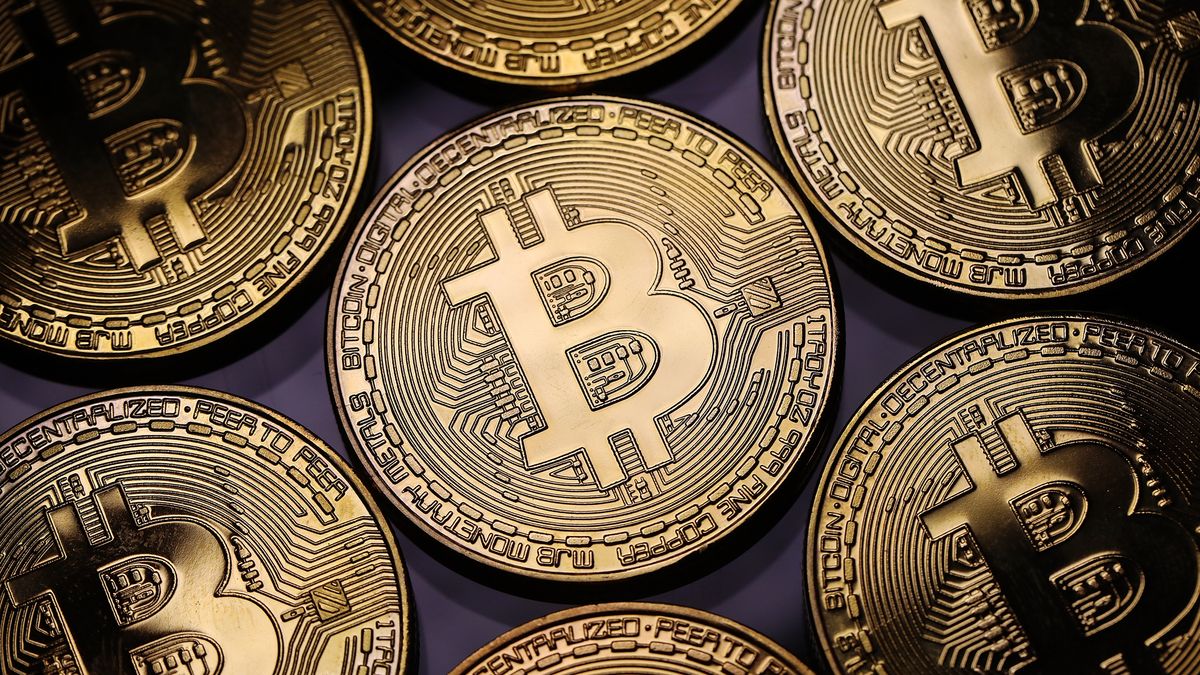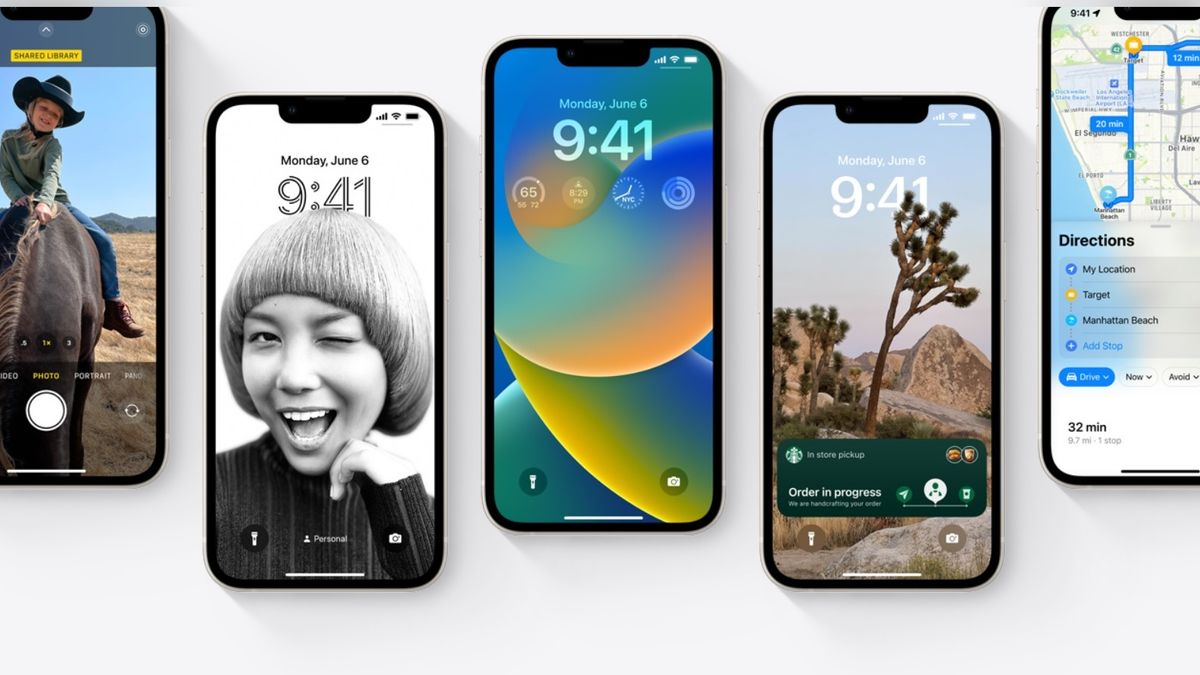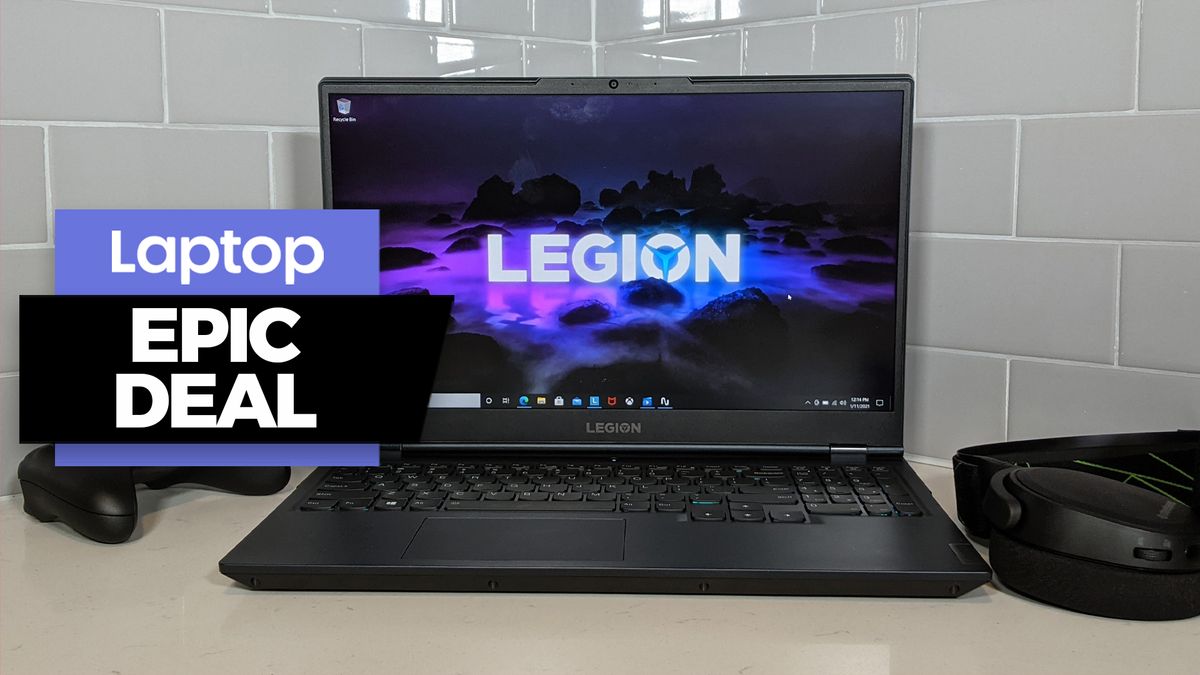Note: This is not financial advice. This is for educational purposes only. Please note that cryptocurrency is a highly volatile asset class; only invest what you can afford to lose.
“How to buy Bitcoin” is still a popular Google search query despite the current volatile cryptocurrency climate. Why? Well, as the old saying goes, “buy low, sell high.” As Bitcoin’s price gets slashed to a fraction of its all-time high of $64,000, investors are scooping up the most popular cryptocurrency at a discount.
Perhaps you, too, want to take a risky plunge into the Bitcoin bonanza, but you don’t know how to get started. Fortunately, it’s a lot easier than you may think. Not only is Bitcoin a well-established cryptocurrency, but it’s the most widely used digital asset in the world, so you don’t have to jump through hoops to buy it (unlike SafeMoon).
Before you buy Bitcoin, you should know what you’re getting yourself into. We’ll dive into what, exactly, is Bitcoin — as well as its pros and cons — so that you’re well informed of the risks involved with purchasing Bitcoin.
What is Bitcoin?
Bitcoin, the brainchild of Satoshi Nakamoto, was born out of fury against the traditional monetary system, especially after the devastating 2008 financial crisis.
The housing market collapsed, millions lost their jobs, retirement accounts plummeted to painful lows — it was an absolute nightmare. Institutional trust took a nosedive; Americans were enraged that their wealth was jeopardized due big banks’ shady practices.
Determined to launch a financial system without central authorities (e.g. banks and governmental bodies), Nakamoto launched Bitcoin in 2009. Bitcoin is a virtual currency that uses a blockchain technology, or a peer-to-peer network, that thwarts third-party middlemen from taking over and calling the shots. If the word “blockchain” is too abstract for you, simply imagine a network of computers communicating with each other to validate transactions. Anyone can participate in the Bitcoin blockchain.
If you decided to hop on the Bitcoin network, you’d be called a “miner.” You’d need powerful hardware to solve mathematical algorithms to confirm incoming transactions, and in return, you’d receive Bitcoin rewards for your contributions. However, because Bitcoin mining is an energy-guzzling practice, it’s drawing the ire of green advocacy groups.

Even Nvidia is trying to discourage Bitcoin miners from buying their gaming graphics cards (GeForce RTX 30-series GPUs are gems for miners who want to earn Bitcoin at speedy rates). However, Nvidia is poised to release a mining-focused graphics card (opens in new tab) soon.
While Bitcoin disrupts the GPU industry, it’s also shaking up the worldwide economy. Bitcoin wasn’t taken seriously at first, but as several major tech firms like Tesla, MicroStrategy, Paypal and Square stockpiled the cryptocurrency, faith in Bitcoin strengthened. Hell, a whole nation (i.e. El Salvador) decided to adopt Bitcoin as legal tender, so it’s solidifying its footing in the financial world.
Bitcoin pros
Some aspects of the popular currency are worrisome. But before we dive into the negatives, let’s start with the pros.
1. You can purchase a fraction of a Bitcoin. Bitcoin’s value climbed to tens of thousands of dollars, which may spook beginner investors with a small budget. Fortunately, you can buy a fraction of a Bitcoin. If you wanted to buy only $10 worth of BTC, no one would stop you.
2. Bitcoin is the most well-established cryptocurrency in the world. It scored acknowledgment from big-name tech firms — and even a country — so it’s likely to stick around for a while (as opposed to SafeMoon and Shiba Inu).
3. Bitcoin is the most accessible cryptocurrency. You can buy and sell Bitcoin on all major exchanges.
4. Bitcoin’s mission is to decentralize the financial system. In the same way the birth of the internet “decentralized” information (e.g. people are no longer dependent on a select few TV authorities to get news), Bitcoin seeks to nix finger-wagging authorities and promote a peer-to-peer system instead.
5. Bitcoin’s reputation as being an “illicit-activities avenue” is unfounded. Criminals wouldn’t touch Bitcoin with a ten-foot pole. According to Decrypt, a former CIA director admitted that the cryptocurrency is a boon for surveillance. In fact, investigating misconduct on Bitcoin’s blockchain is much easier for crime fighters than tracking illegal transactions on traditional financial systems.
Bitcoin cons
1. Bitcoin is a dinosaur. Every year, new crypto projects pop up to stick their tongues out at Bitcoin and sing, “Anything you can do I can do better! I can do anything better than you!” And honestly, they have a point. Bitcoin is old and decrepit. At any moment, a young, vivacious crypto network can outperform Bitcoin and steal its shine.
2. Bitcoin is slow AF. Transferring Bitcoin from a Coinbase account to another wallet could take almost 24 hours! Now, it doesn’t always take this long. The average transaction time is 10 minutes. However, a congested network can hinder your transaction. A paltry network fee can halt it, too. In other words, if the transaction fee you’re offering to miners is too low, you’ll get deprioritized and sent to the back of the line.
3. Bitcoin is volatile. Hang on, tight! Bitcoin is a rollercoaster. The price could be $60,000 one day and drop down to $20,000 at a moment’s notice.
4. Bitcoin is expensive. Bitcoin is pricey, which means that the room for potential growth is narrower compared to other altcoins.
5. Bitcoin is extremely susceptible to news and tweets. In 2021, Bitcoin’s downturn was caused by Elon Musk environment-concerned tweet, but at the same time, Bitcoin’s rally to $64,000 was partially propelled by Tesla’s news of accepting Bitcoin as payment.
Now that you have a general idea of what you’re getting into, let me show you how to buy Bitcoin.
How to buy Bitcoin
Coinbase is arguably the most beginner-friendly exchange — it’s like the Robinhood app of crypto platforms. Coinbase is insured to protect its customers from hacks, the UI is as smooth as a baby’s bottom, and it even offers free crypto if you watch short educational videos. Once you sign up and link your bank account to Coinbase, here’s how to buy Bitcoin.
1. Click on the “Buy/Sell” button on the top-right corner of the homepage.
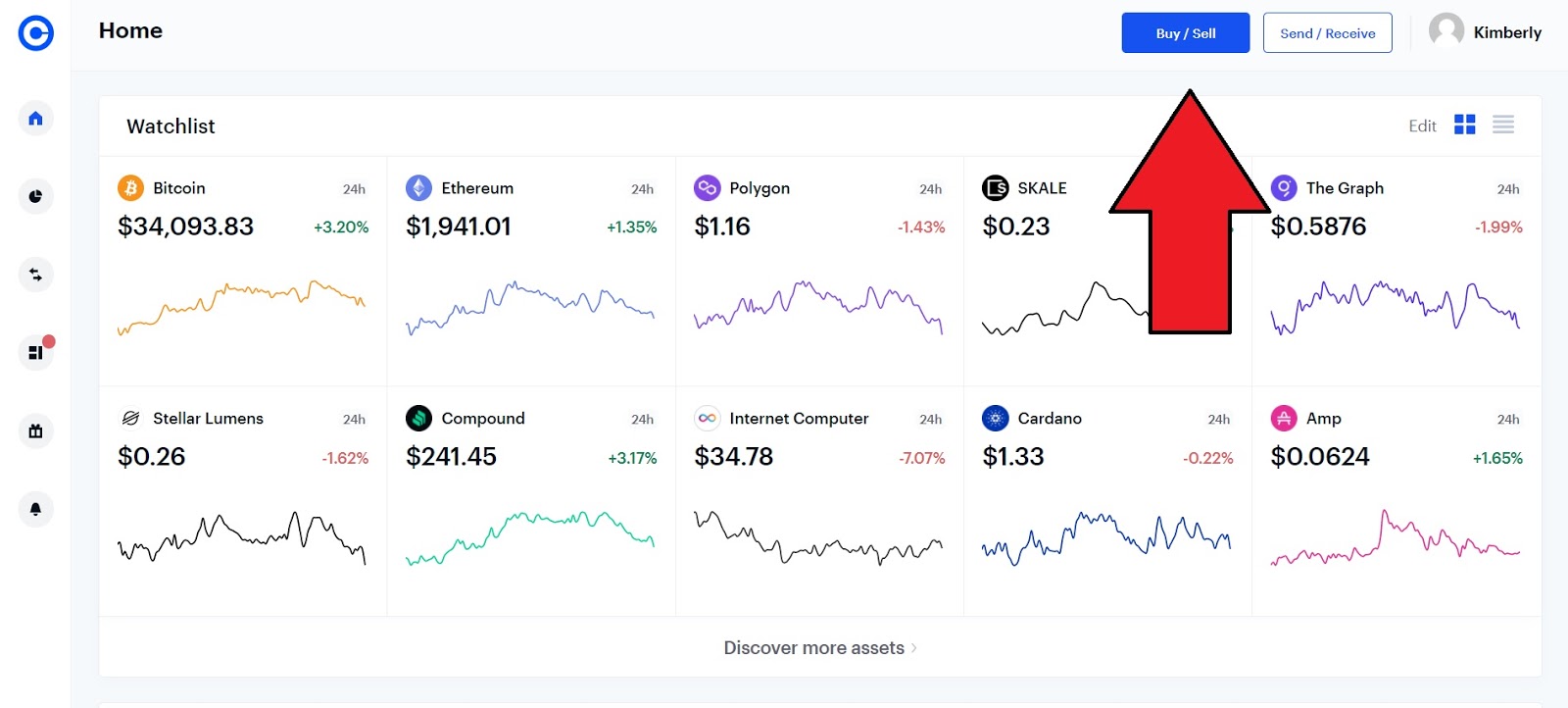
2. A small window will appear with three tabs: Buy, Sell and Convert. Make sure “Buy” is selected.
3. Fortunately, Bitcoin is the default cryptocurrency, so you don’t need to go through the hassle of selecting the digital asset you want to purchase from the drop-down menu.
4. You can choose from five pre-selected amounts on how much Bitcoin you’d like to purchase: $10, $50, $100, $500 and 1,000. Or, if you prefer, you can click “Custom” to type in a specific amount.
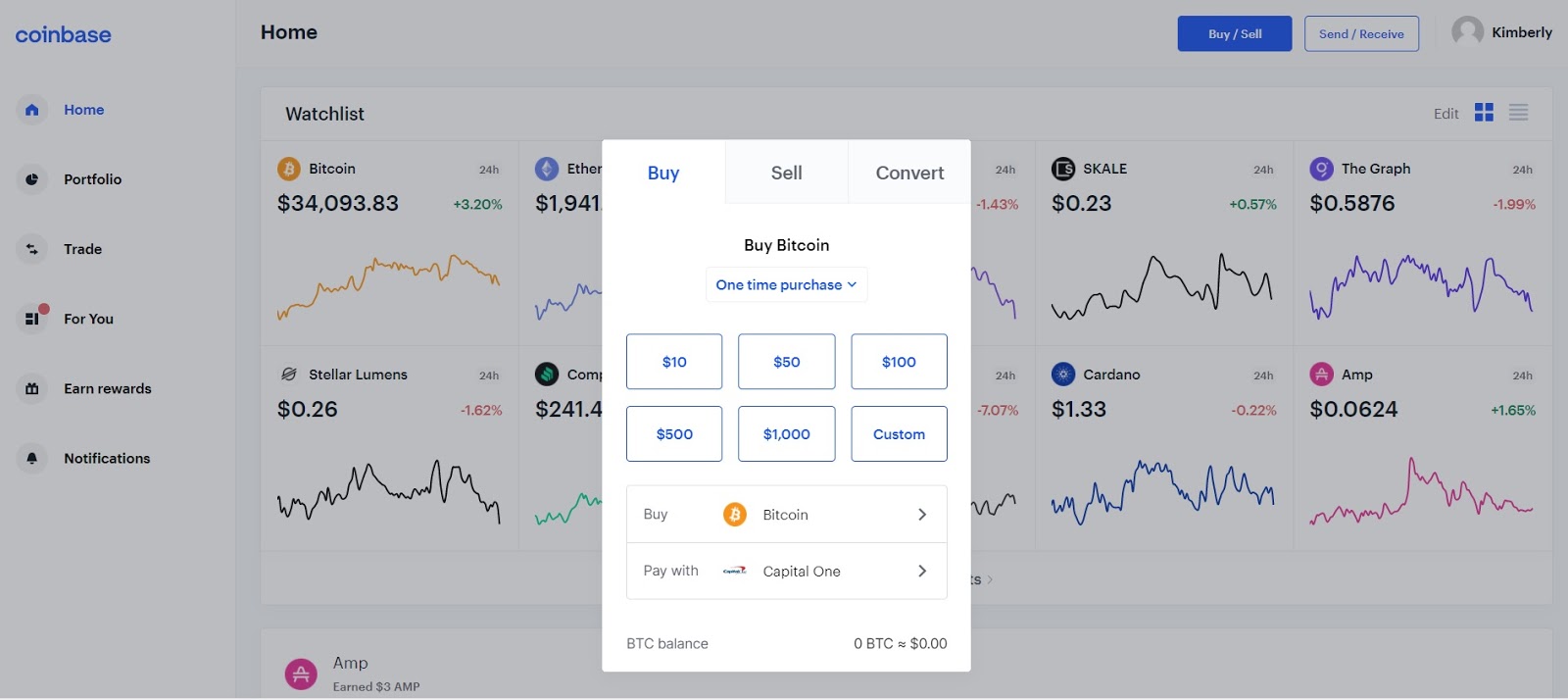
5. A new window will appear. This is your Order Preview. Review everything to make sure everything is accurate; you’ll also see the Coinbase fee for the transaction.
6. If you’re OK with everything, click “Buy Now.”
Congratulations! You’re now a Bitcoin holder. Moving forward, I’d suggest getting a Ledger Nano S (opens in new tab) (a USB hardware wallet device) to store your newly acquired Bitcoin offline. That way, even if something sinister happens to Coinbase, you’ll still have your Bitcoin safe and sound.

